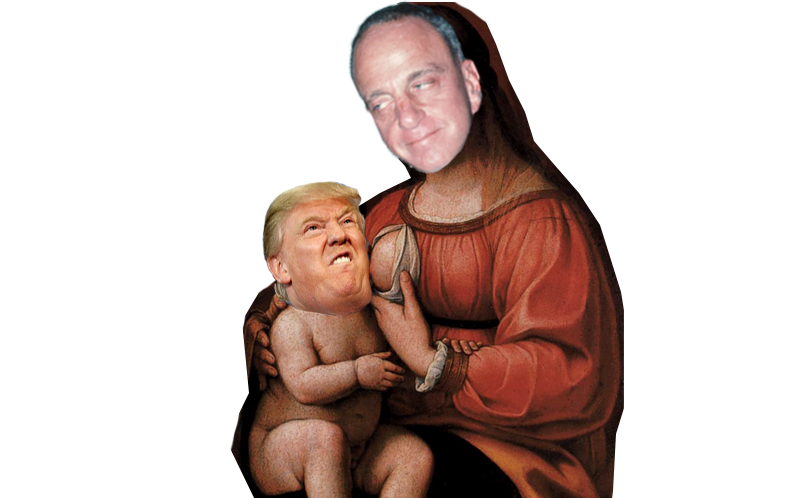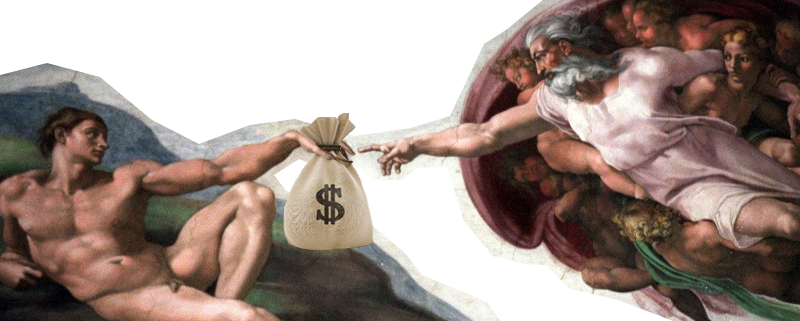“You can never make that crossing that she made, for such Great Voyages in this world do not any more exist. But every day of your lives the miles that voyage between that place and this one you cross. Every day. You understand me? In you that journey is.”
— Angels in America, Millennium Approaches, Act 1, Scene 1
At the end of Ithaca College’s production of Millennium Approaches in October 2017, the lights flickered and we — the audience and Prior Walter — met the Angel for the first time. As both a reader and an audience member, I have immersed myself in this play countless times over the last 25 years — at the American Conservatory Theater in San Francisco in 1995, in the Off Broadway revival, during many viewings of the superb HBO production. I look forward to seeing the current Tony-award-winning version of the play, its first Broadway production in the Trump era. When we finally meet the Angel at the end of Millennium, it is a spectacle. In the text and in previous productions, her entrance is preceded by a giant boom that causes part of the bedroom ceiling to crash down to the floor. When she descends and asserts, “The Great Work begins!” it is significant, stunning, and terrifying. In Ithaca College’s otherwise phenomenal production, the Angel entered . . . on roller skates.
All throughout this production, I was mesmerized yet again by Tony Kushner’s gorgeous words, his mastery of dialogue, his hope in the face of great uncertainty and fear, and the incredible skill of the acting students who embodied his vision. But even before the somewhat perplexing roller skating anticlimax, I was thinking about how historical context affects how we experience a play. In 2018, for those with access to health care, HIV has become a chronic illness, not a death sentence. Anti-retroviral therapy (ART) has been the main approach to treating HIV/AIDS for the last 20 years. Over time, the drugs have become more effective at suppressing HIV replication, have fewer side effects, and have become less toxic. These improvements have literal life-and-death implications. A new study published in The Lancet shows that, for a 20-year-old patient starting anti-retroviral treatment between 2008 and 2010 and who had a CD4 count of more than 350 cells per µL one year after treatment, the average life expectancy was 78 years, approaching the life expectancy of the uninfected. In fact, in September 2017, on National Gay Men’s HIV/AIDS Awareness Day, the Centers for Disease Control put out a statement that said that HIV-positive people taking effective anti-retroviral therapy cannot even transmit the virus. Treatment is in essence prevention.
Angels in America takes place at the dawn of the AIDS crisis and was written during its height — the first play, Millennium Approaches, debuted in 1990 and the second play, Perestroika, in 1992. In these plays, Prior, the heart of the play, compared his post-AIDS-diagnosis reality to a story of a shipwrecked crew: “people in a boat, waiting, terrified, while implacable, unsmiling men, irresistibly strong, seize . . . maybe the person next to you, maybe you, and with no warning at all, with time only for a quick intake of air you are pitched into freezing, turbulent water and salt and darkness to drown.” An air of death, fear, and uncertainty surrounded an AIDS diagnosis in the 1980s and 1990s, but circumstances have since changed. Was the Angel’s playful roller skating entrance a sign of this changed reality?
“Everyone who makes it in this world makes it because somebody older and more powerful takes an interest. The most precious asset in life, I think, is the ability to be a good son . . . Somebody who can be a good son to a father who pushes them farther than they would otherwise go. I’ve had many fathers, I owe my life to them, powerful, powerful men.”
— Roy Cohn, Millennium Approaches, Act 2, Scene 4
One reality that has not changed since the debut of Angels in America is the political presence of Roy Cohn. Roy Cohn is the other main character in these plays afflicted with HIV/AIDS. Roy Cohn the character is based on real-life Roy Cohn, a closeted gay lawyer who rose to power by being a good son to Joseph McCarthy. Early in his career, he had made a name for himself in the trial of Julius and Ethel Rosenberg, pushing for their eventual execution. In his own autobiography, he said that he personally influenced the selection of the chief prosecutor and judge in that case, even making an ex-parte death penalty recommendation. He continued his legal ascent during the McCarthy hearings on Communist activity, as chief counsel.
Cohn, in turn, was a father figure to Donald Trump. Cohn first met Trump when he represented him against the Justice Department’s claim that Trump violated the Fair Housing Act, a claim that alleged different rental terms and false “No Vacancy” signs in response to prospective African American tenants. His lawyer for 13 years, Cohn fought Trump’s battles and helped expand his business empire and prominence. A New York Times article by Jonathan Mahler and Matt Flegenheimer quoted Trump saying this about Cohn: “He’s been vicious to others in his protection of me.” He was more than his lawyer; he was a mentor, confidant, and dear friend, often talking to him multiple times a day.
When I first read about the Donald Trump — Roy Cohn connection, I was at the same time amazed and totally unsurprised. But at that time, I, like most progressives, was certain that Trump’s candidacy was a joke — that the mainstream Republican establishment could and would quash his quest for power. Candidate Trump was and President Trump is playing from the Roy Cohn playbook. The smearing of opponents. The crass language. Using the news cycle to his advantage. The focus on loyalty.
Loyalty was tremendously important to Roy Cohn and it is to Trump as well. But Trump’s focus on loyalty is solely about other people being loyal to him, without question. He does not return those favors, or that loyalty. After Roy Cohn was diagnosed with AIDS and was facing disbarment for unethical conduct, Trump took his business elsewhere. Once Cohn wasn’t useful to him anymore, Trump’s loyalty disappeared. He was the good son who became the bad son. 30 years after Cohn’s death from AIDS, however, as his Attorney General recused himself from the Russia investigation, Trump seemed to have recognized his father figure’s usefulness once again. He enjoined, “Where’s my Roy Cohn?”
“Make HIV AIDS Again”
— thebody.com, March 16, 2017
HIV/AIDS has transformed into a chronic illness over the last 25 years precisely because people were able to access the health care and prevention tools they needed and felt safe to do so, without fear of discrimination and stigma. But the Trump Administration’s attempts to repeal the Affordable Care Act as well as their LGBTQ-rights rollbacks are endangering people’s lives yet again. These policies have the power to erase progress against the disease and make the Angel crash again through the ceiling.
In the same statement that discussed the inability to transmit the virus with proper anti-retroviral treatment medication, the CDC said, “among gay and bisexual men living with diagnosed HIV, 61% have achieved viral suppression, more than in previous years, but well short of where we want to be.” They noted that society needs to address the barriers “that make it more difficult . . . to get HIV care and treatment.” Socioeconomic factors, access to health care, and stigma and discrimination all affect HIV prevention and care services. The Trump Administration’s actions and political philosophy embody and create what theater scholar Claire Gleitman describes as the source of the play’s tragedy in “Tony Kushner: Triumphing Over Tragedy”: “the unraveling of that net of souls” which constitutes a human community, “because of a collective abandonment of the collective.”
Unlike many other countries, America doesn’t have a uniform health care system for all of its citizens. The American health care system is like a patchwork quilt — people have very different types of health care plans depending on a variety of factors — age, employment status, veteran status. Many people fall through the cracks of this system. The vast number of uninsured people is the shame of the American health care system. While the Affordable Care Act was created to help deal with this, it was not a complete overhaul of the American health care system, but rather a strengthening and broadening of this patchwork system.
The Affordable Care Act has been under attack since the moment it was signed into law on March 23, 2010. “Repeal and Replace” became the rallying cry of Republicans. In 2012, two major tenets of the bill came under review by the Supreme Court — the individual mandate, which states that everyone needs to purchase health insurance or be subject to a penalty, and the required Medicaid expansion by states. The Supreme Court upheld the individual mandate but made Medicaid expansion optional. Between 2012 and the present, there were many other failed attempts to repeal the individual mandate, each of which generated major ire from constituents, even in Republican districts. However, the repeal of the individual mandate finally happened in December 2017, as part of the hastily-written Republican tax plan.
The individual mandate is an essential component of the Affordable Care Act; in fact, it is one of the ways to make health care actually “affordable.” In order for health insurance to be affordable, the healthy must subsidize the sick. There is asymmetric information in insurance markets — patients know more about their medical histories and overall health status than insurance companies do. And insurance companies do not like this. The potentially healthy and potentially sick are pooled together, and insurance companies cannot differentiate the two. The insurance premium is calculated based on the likelihood of illness for the group as a whole. Everyone, regardless of health care utilization, pays a health insurance premium — it is a certain, small loss that protects you from that uncertain, big loss that is costly illness. The size of the insurance premium for the pool is based on “expected loss,” that is, the probability of illness multiplied by the cost of the bad event. The “expected loss” for healthy people is much smaller than the “expected loss” for sick people. So healthy people often will believe that the pooled premium is too expensive based on their level of risk and leave the insurance pool. Their absence increases the probability of illness of the pool. The insurance companies know this, so in order to cover their costs of a riskier pool, they increase the premiums. This increase in premiums makes even more people leave the market. We economists call this process “adverse selection.” The market selects and selects and selects until only sick people remain — paying exorbitant premiums. In effect, it ceases to be insurance. The non-partisan Congressional Budget Office predicts that getting rid of the individual mandate will lead to four million fewer people being insured in 2019, rising to 13 million fewer by 2027.
The Trump administration is abandoning the collective in both the American and global realms. Since the early years of HIV, regardless of political affiliation, treatment was considered an essential part of the strategy to stem the AIDS epidemic. George W. Bush, nobody’s idea of a progressive icon, started the President’s Emergency Plan for AIDS Relief (PEPFAR) in 2003. PEPFAR focuses on treatment, prevention, and compassionate care in sub-Saharan Africa. The Trump administration is changing this. As Republican speechwriter Michael Gerson reports in the Washington Post, Trump “wants to gut America’s progress against AIDS,” proposing an $800 million cut in America’s bilateral HIV/AIDS programs as well as a $225 million cut in the Global Fund. Gerson writes, “when you are not moving forward against an epidemic, you end up moving backward, and rapidly.”
Stigma and discrimination can affect whether or not someone even seeks testing, treatment, and care. December 2017 was a very active month for the Trump administration in terms of stigmatizing and neglecting the LGBTQ community and people with HIV/AIDS. To begin the month, his statement for World AIDS Day intentionally failed to mention the LGBTQ community, a group disproportionately affected by the disease. In mid-December, the Trump Administration forbade the Centers for Disease Control from using seven words in 2018 budget documents — diversity, fetus, transgender, evidence-based, vulnerable, entitlement, and science-based. He ended the month by firing every member of the Presidential Advisory Council on HIV/AIDS, a group of experts, community members, and people living with HIV/AIDS who offer recommendations for responding to the epidemic. One year into the Trump presidency, LGBTQ Americans are feeling the effects of this backslide — A November 2017 GLAAD and Harris Poll found that 55 percent of LGBTQ Americans experienced discrimination because of their gender identity or sexuality that year, up 11 percentage points from the previous year. Other questions in that survey highlighted the tangible effects of ignorance and fear — it found that almost one in three Americans would be uncomfortable if they knew their doctor was an LGBTQ person, significantly higher than the year before. This new political atmosphere and the active silencing of experts who don’t align with the Trump agenda may have long-term consequences for development of new treatments and dissemination of treatment and health information.
In AIDS and Its Metaphors, Susan Sontag writes, “the move from the demonization of the illness to the attribution of fault to the patient is an inevitable one no matter if the patients are thought of as victims. Victims suggest innocence. And innocence, by the inexorable logic that governs all relational terms, suggest guilt.” She also warns of the real power that illness metaphors and stigma have: “they inhibit people from seeking treatment early enough, or from making a greater effort to get competent treatment. The metaphors and myths, I was convinced, kill.”
Even Roy Cohn himself, the ultimate stigmatizer, was harmed by these myths and metaphors. When denying his diagnosis (calling it liver cancer, not AIDS), the character said, “Roy Cohn is not a homosexual. Roy Cohn is a heterosexual man . . . who fucks around with guys.”
His doctor, channeling Sontag, replied, “you can call it any damn thing you want, Roy, but what it boils down to is very bad news.”
•
“This disease will be the end of many of us, but not nearly all, and the dead will be commemorated and will struggle on with the living, and we are not going away. We won’t die secret deaths anymore. The world only spins forward. We will be citizens. The time has come.”
— Angels in America, Perestroika, Epilogue
The epilogue of the plays occurs five years after the end of Perestroika. Prior is now living with AIDS, not dying from it. Five years earlier, he had been given some contraband AZT from Roy Cohn’s secret stash — this Robin Hood-like medical act might have been his turning point. During the political moment of the plays, President Reagan had still not addressed the epidemic — he didn’t actively address HIV/AIDS until 1987, after five years and 23,000 deaths. Our political moment is reminiscent of the political reality of Angels in America, with Trump’s sabotage mirroring and even transcending Reagan’s willful indifference. But even in the face of funding cutbacks and forbidden words there is still forward movement and hope. Scientists are discovering new treatments, policymakers are accessing underrepresented communities, and activists are helping decrease stigma.
The CDC is working on reducing the number of new HIV infections in a multifaceted approach, including funding “at least $330 million per year to health departments for HIV prevention among the most affected populations,” encouraging testing in the most affected communities, and supporting prevention interventions like PrEP.
The Trump Administration is trying to fray the net of souls and put a halt to what progress has been made. Indeed, our own moment is sufficiently grim as to leave one tempted to question the sublime hopefulness of Kushner’s ending. In light of all of these rollbacks, the roller skating interpretation might change from somewhat flippant to troubling in itself — introducing the audience to an Angel whose wings seem not to work and is forced to rely on roller skates.
The morning after Trump was elected, I woke up worn out, after a night of many tears and little sleep. I thought about my then four-year-old daughters — they were born into this world as female; they have a queer family. Once they claim their own sexuality and gender identity, they may be LGBTQ themselves. How would I ever be able to keep them safe? In the midst of all of this, I thought of Kushner’s clarion call in the Epilogue: “We will be citizens.” This line had always resonated with me but even more so that morning. As I got out of bed and faced the day, I took comfort in the hope that people known and unknown to me — good and decent and loving people — would protect me and my family. And I would use my own particular privileges to protect others.
Since that morning, there has been pushback, out in the streets and in elections. In 2017, Maine voters circumvented their state government and voted to expand Medicaid. On that same day, a transgender woman in Virginia, Danica Roem, unseated the person who sponsored the “bathroom bill” against transgender individuals. In December 2017, Doug Jones became the first Democrat to win a US Senate seat in Alabama in 25 years. There is resistance and that resistance is building every day, as more women, people of color, LGBTQ people, and people with disabilities run for office, vote, and make their voices heard. We need Angels in America as much as — perhaps even more than — ever. The world only spins forward. The Great Work Begins. Again. •
All illustrations by Isabella Akhtarshenas.







